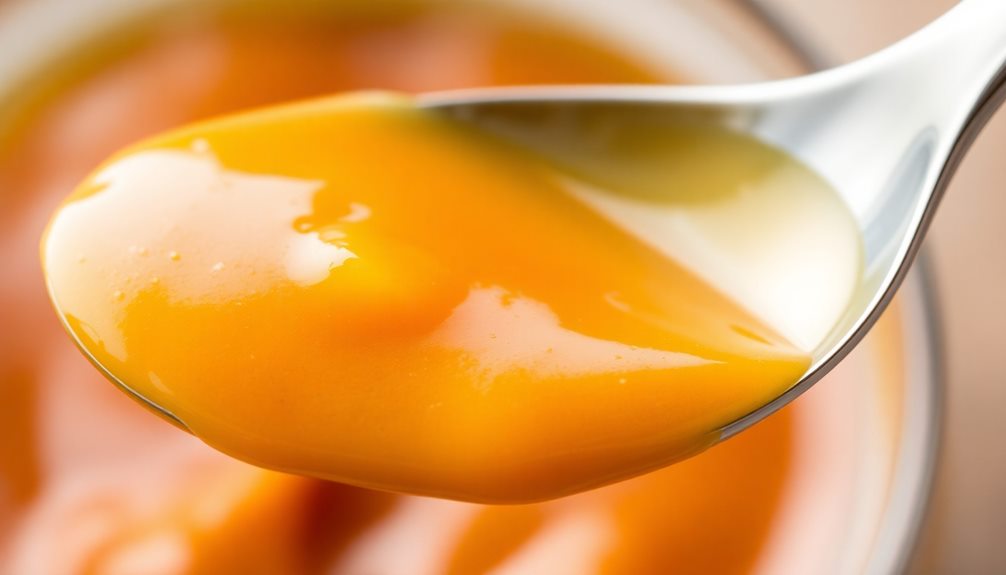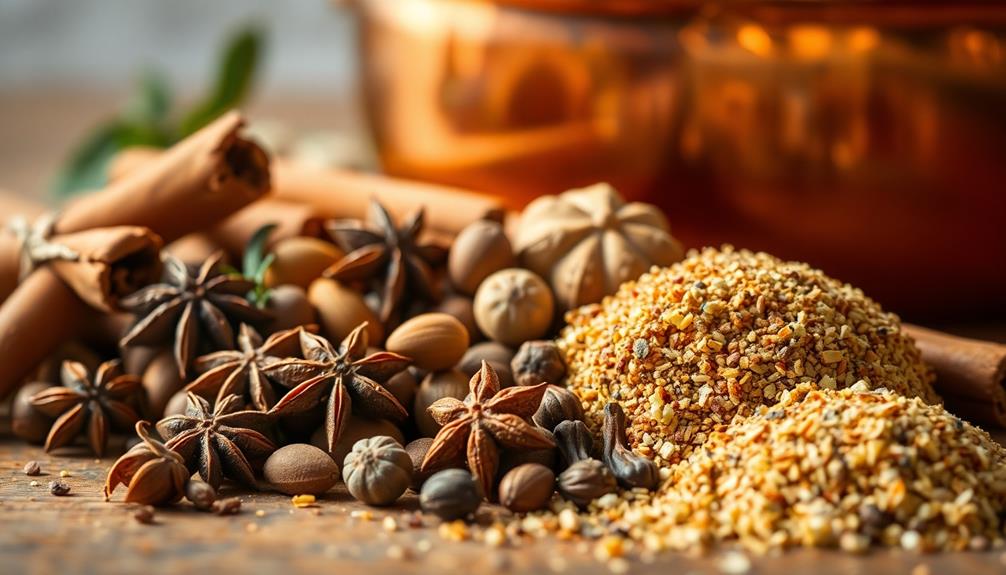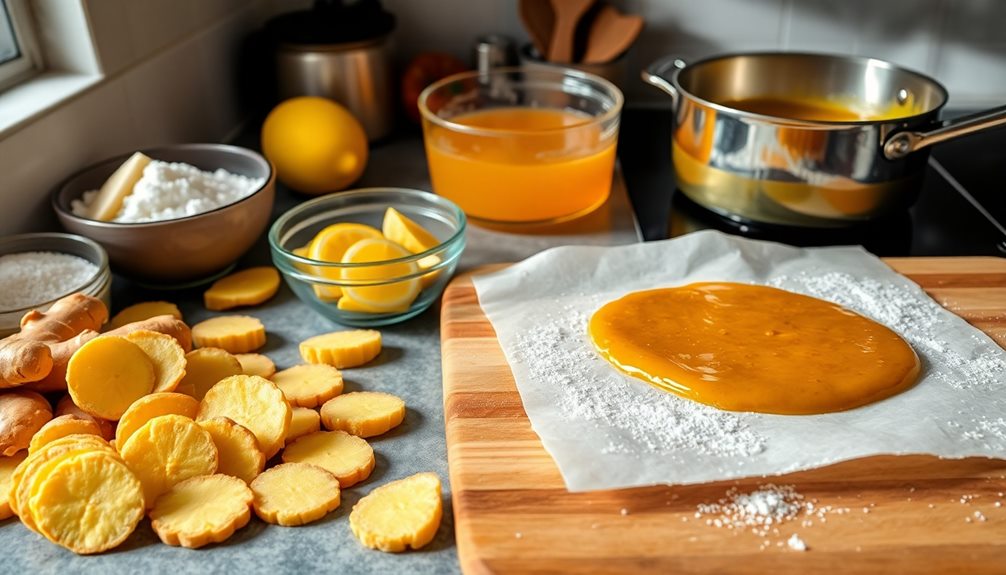To keep holiday leftovers safe, cool them quickly within two hours and store in airtight containers in the fridge at or below 40°F. Reheat only once until the internal temperature reaches at least 165°F, using a thermometer to confirm. Avoid thawing leftovers at room temperature and freeze any unused portions promptly. Proper storage and reheating help prevent bacteria growth and spoilage—continue exploring tips to enjoy your leftovers safely.
Key Takeaways
- Cool leftovers to room temperature within 2 hours and store in airtight containers.
- Keep the refrigerator at or below 40°F (4°C) and avoid overloading for proper air circulation.
- Reheat leftovers to an internal temperature of 165°F (74°C) using a food thermometer for safety.
- Reheat leftovers only once to prevent bacteria growth and maintain quality.
- Freeze leftovers if not consumed within a few days, and thaw safely in the refrigerator, cold water, or microwave.

After enjoying a festive meal, it’s tempting to keep leftovers for later, but proper food safety is vital to prevent illness. The first step is to focus on proper storage techniques. Once you’ve finished your meal, let the leftovers cool down slightly—ideally to room temperature within two hours—before placing them in airtight containers. This prevents bacteria from multiplying rapidly. Store hot foods in shallow containers to allow quick cooling and make sure they fit easily into your refrigerator. Keep your fridge at or below 40°F (4°C), and avoid overloading it, as proper air circulation helps maintain a consistent temperature. Remember, leftovers should be labeled with the date they were stored, so you know exactly when to consume or discard them. Monitoring temperature control is essential for food safety, especially in preventing bacterial growth.
When it comes to reheating guidelines, you want to guarantee leftovers are heated thoroughly to kill any lingering bacteria. Use a food thermometer to verify that the internal temperature reaches at least 165°F (74°C). This is especially important for meats, stuffing, and other dishes prone to bacterial growth. Reheat leftovers evenly by stirring or rotating during the process—whether you’re using a microwave, oven, or stovetop—to avoid cold spots where bacteria might survive. Cover dishes with microwave-safe lids or wraps to trap moisture and heat evenly. For microwave reheating, allow the food to rest for a minute or two after heating to let the temperature stabilize throughout the dish.
It’s vital not to reheat leftovers multiple times. Each reheating cycle increases the risk of bacteria growth and reduces the quality of the food. If you don’t plan to eat leftovers within a few days, consider freezing them. Frozen leftovers can be kept for longer periods—usually three to six months—without losing quality or safety, as long as they’re stored properly in airtight containers or freezer bags. When you’re ready to eat frozen leftovers, thaw them safely in the refrigerator, in cold water, or in the microwave, never at room temperature.
Frequently Asked Questions
How Long Can Leftovers Stay Safe in the Refrigerator?
You can safely store leftovers in the refrigerator for up to 3 to 4 days, ensuring they stay fresh and safe to eat. After this storage duration, spoilage signs like off smell, slimy texture, or discoloration may appear, indicating it’s time to discard. To prevent spoilage, always store leftovers in airtight containers and keep your fridge at or below 40°F. When in doubt, throw it out for safety.
What’s the Best Way to Reheat Leftover Turkey?
To properly reheat leftover turkey, you should use a microwave, oven, or stovetop, ensuring even heating. The key is reaching a safe temperature of 165°F (74°C) to kill bacteria. Cover the turkey to retain moisture and prevent splatters. Stir or rotate during reheating to promote even heat distribution. Once it hits the safe temperature, it’s ready to enjoy without worry about foodborne illness.
Can Leftovers Be Frozen and Still Taste Good?
Yes, leftovers can be frozen and still taste good if you freeze leftovers promptly and use airtight containers. Freezing leftovers helps preserve their flavor, but for the best taste, try to consume them within a few months. Make sure to label your containers with dates, and reheat thoroughly to enjoy leftovers with flavor preservation. Proper freezing techniques keep your food safe and delicious for later enjoyment.
How Do I Know if Leftovers Have Gone Bad?
Leftovers have gone bad if they don’t smell or look right, even if the expiration date isn’t reached. You might notice a sour odor, slimy texture, or discoloration—clear signs of spoilage. Always trust your senses over dates; if something seems off, it’s safer to discard it. Proper storage and timely consumption prevent foodborne illnesses, so stay vigilant and enjoy leftovers safely.
Are There Any Leftovers I Should Avoid Reusing?
You should avoid reusing leftovers that show signs of mold growth or an off smell, as these can cause food poisoning. Also, steer clear of leftovers that have been stored for more than 3-4 days, since bacteria can grow and increase the risk of illness. When in doubt, it’s safer to discard questionable leftovers to prevent food poisoning and ensure your health.
Conclusion
Remember, your holiday leftovers are like treasures waiting to be enjoyed safely. Store them in airtight containers and refrigerate promptly, so they stay fresh and tasty. When reheating, make sure they’re steaming hot all the way through, just like a cozy, bubbling pot on the stove. By following these simple tips, you’ll keep your holiday feast safe and delicious, turning your leftovers into warm, inviting bites that bring everyone together again.










